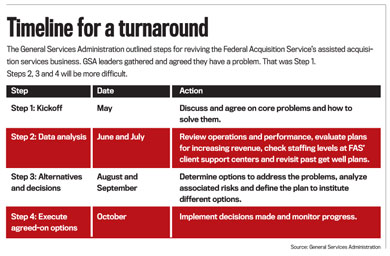GSA: We’re focusing on assisted services

Agency readies a four-step recovery plan.
ORLANDO, Fla. — Senior officials at the General Services Administration say they have a four-step plan to pull the agency’s assisted acquisition services business out of debt by fiscal 2008. Officials say they are determined to change the way the program works by getting to know customers better.
The Federal Acquisition Service expects its assisted acquisition services business to lose as much as $60 million this fiscal year based on expected revenue of $3.7 billion. GSA charges fees of about 4 percent on that revenue.
The service’s business has slipped since fiscal 2004. Total business from its information technology and professional services offerings that year reached $7.7 billion. But by the end of fiscal 2006, business had dropped by $3.3 billion and was bringing in only $4.4 billion, according to GSA’s figures.
Officials said those losses have hurt the agency.
“We cannot sustain these types of losses year after year,” said Ed O’Hare, FAS’ assistant commissioner in the Office of Strategic Business Planning and Process Improvement. “We must do something about this.”
GSA’s new four-steps-to-recovery strategy looks similar to a plan it developed in 2003 with the Get It Right campaign and its aftermath.
GSA began developing and then decided to scrap a customer relationship management system because the system didn’t work after more than two years into a $46.6 million contract. Now, as at numerous times in the past three years, GSA’s top officials say meeting customer needs is their No. 1 job.
GSA officials have begun an analysis of the problems, but they’ve also decided to take some immediate steps. To decrease its in-house costs, FAS plans to reduce the number of different e-tools that it uses in its client support centers. Mary Davie, FAS’ assistant commissioner at the Office of Assisted Acquisition Services, is working with FAS’ chief information officer, Casey Coleman, to create a common set of tools. Greater standardization could reduce costs, she said.
Davie also wants to shift work from overburdened centers to those with less work.
The agency is considering other cost-control measures, including a hiring freeze.
Workforce adjustments could affect employees, but the measures would not include reductions in force, O’Hare said.
FAS may expand its array of professional and consulting services. GSA officials had the same plan in 2002. Officials are meeting with industry to develop business plans for the client support centers and get a better understanding of the phases of cost recovery.
To recover costs, FAS may create a national pricing policy as early as June. Such a policy is only preliminary at this stage, but GSA officials said the policy would establish a minimum standard surcharge based on the services' dollar amount. The standard charge would eliminate customer confusion by ending variances among the regions.
Officials may also institute what they call an accrual cleanup process to flag outstanding accounts and recover payments. That process would eliminate direct hits to the gross margin of GSA’s assisted acquisition services business. If GSA got all of its payments, the agency estimates it could bring in as much as $15 million this year.
To develop new business, GSA is researching its customers’ spending habits, especially those of civilian agencies. Officials in GSA’s regional offices submitted information on opportunities they see for business.
O’Hare and Davie said FAS would not go down every avenue in search of new business. It will rely instead on market research. But Davie added she does not expect the business to earn $7.7 billion a year in revenue ever again.






